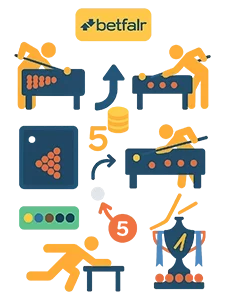This handbook prioritises live wagering for UK viewers, centred on major tournaments. In-play means reacting during frames; pre-match covers research, modelling, line-ups beforehand.
Snooker Bookmakers Not on GamStop
Use information ethically: rely on broadcasts, permitted statistics, transparent sources; avoid insider channels. Stake responsibly through small units, consistent bankroll rules, clear limits, periodic cooling-off. Combine table-side reads with market indicators such as liquidity, odds movement, volatility, tempo shifts. Sections deliver actionable guidance through workflows and examples.
In-Play Snooker Betting Micro-Momentum Signals UK Punters Should Use

Micro-tempo means noticing miniature changes in pace, routine, and surface behaviour that often front-run price movement by a shot or two. Arena pictures reveal whole-body signals, travel speed, bounce, slide, plus cue maintenance; broadcast angles highlight tip contact, grip pressure, bridge height, eye-line stability. Combine both views to build a reliable read. Record first impressions in brief notes, then seek confirmation across two visits before staking. Use discipline, because single moments can mislead without context. Tempo patterns in frames commonly precede tactical pivots: slowing usually foreshadows safety exchanges; brisk rhythm implies potting intent. Treat every cue as probabilistic, never certain. Apply in-play betting tips only when observation, market behaviour, and frame state align, improving entry timing and exit control during volatile phases. During live frames, compare arena audio with commentary delay; muted tables tell stories through walk speed, shot pre-sets, and cloth shine. Maintain a minimal notation template: time, player, cueing change, table speed, market tick. Review notes at each mid-session interval. Build an in play betting strategy around confirmation, liquidity, tick speed, structure.
- Set-up changes after awkward leaves
- Ball travel speed and cushion reaction
- Routine cadence: chalk, rest, walk-around
- Opponent responses after tactical sequences
Live table-side signals to watch
Anyone can read table-side signals without live data feeds. Stance resets often appear after indecision, revealing alignment doubts or sighting corrections. Chalking cadence hints at comfort levels: shorter, consistent motions imply calm, while hurried dabs suggest flustered thinking. Frequent rest grabs indicate awkward angles or disrupted planning, and prolonged eye-line checks may flag uncertainty around contact points. Start with tiny notes, then verify the first impression over two visits. Use snooker betting tips sparingly; let observations mature before money moves. Build a four-point checklist: who, what, when, effect. Log player, cueing change, timestamp, outcome. After the third sighting, downgrade noise or upgrade signal. That lightweight process balances speed and caution, guarding discipline while capturing actionable detail during live play. Revisit patterns after mini-intervals. Augment tableside reads with sports betting tips ai predictions after measured tracking.
- Stance reset count during consecutive visits
- Chalk rhythm duration between shots
- Rest selection frequency under pressure
- Eye-line hold time at address
Shot pace shifts from safety to potting intent
Confidence announces itself through pace. Shorter settling times, quicker address, and firmer cue-through usually accompany attacking selection. When rhythm accelerates after a solid pot, the next choice frequently upgrades from thin containment to purposeful aggression, such as driving at a long red or opening a small cluster. Markets can trail the cue by a tick, creating windows. Anchor decisions in table context, not emotion. Use snooker tips betting once momentum aligns with layout, leaving room for exits if contact quality fades. Record the first acceleration, wait for a second confirmation, then engage lightly. Protect stake by pre-defining an invalidation point, such as a timid safety where a bold follow-up felt likely. Keep discipline during noisy crowd reactions. Prefer rapid payouts after sessions? Shortlist betting sites fast withdrawal to simplify cash management.
Cue-action rhythm: pre-shot routine lengthening
Elongated pre-shot routines can indicate doubt, re-aiming, or conflict between candidates. Longer looks at contact points, repeated feathers, and chalk strokes often accompany hesitation. However, deliberate composure during hostile table maps can mimic worry while reflecting elite control. Distinguish calm intention from anxiety by comparing rhythm with that player’s earlier visits under similar spots. Hold fire until routine length stabilises across consecutive turns. Deploy tonights snooker betting tips only after sequence normalises and decision time tightens. If pauses persist while execution quality drops, step aside. Late entries during fragile spells tend to underperform because selection clarity has not returned. Wait for two confirming examples of steadier pacing before considering stake, then reassess after the first post-entry shot. Keep judgement anchored by responsible sports betting UK principles throughout tricky momentum swings.
Table speed & cloth run changing after re-rack
Re-racks, fresh cloth wipes, or brand-new balls can alter table speed, slide, and swerve. Length-of-table safeties that previously held die may now over-run; stun checks can grab sooner or skate farther. Detect the new baseline quickly by tracking first contact travel on gentle shots, then update expectations for cannons and checks. Under-hits and over-runs tell you whether timing needs a small nudge. During volatile resets, apply world snooker betting tips cautiously, reducing initial stake until the behaviour stabilises. Map launch pace to landing distance using two or three probes, while noting cushion take-up and return angles. Once measurements settle, models regain usefulness, letting entry timing improve without guessing through changing conditions. When variables shift suddenly, specialists sometimes exploit arbitrage betting UK across independent prices.
Body language tells from players between frames
Between frames, body language can hint at changing mindset, though signals remain probabilistic. Watch towel focus, gaze patterns, cue-tip maintenance, and small chats with officials. Some players project calm through stillness; others reset by moving, stretching, or smiling. Treat every cue as suggestive rather than decisive, and pair a tell with the next two table visits before acting. Use betting insider insight gently, never allowing theatre to outweigh selection quality or layout logic. Keep notes concise so they remain useful during rapid markets, and cross-check mood indicators with shot choice soon after the restart. If posture softens while tempo rises on return, expect aggression. Conversely, slumped shoulders plus slow approach precede containment. Combine both with table map and recent contact quality before committing. Long intervals sometimes suit bargain hunters collecting mobile casino free bonuses UK sparingly.
- Tidy cue-tip work followed by walk-on tempo
- Fixed gaze, breathing, fidgeting during sit-down
- Animated chat, laughs, shoulders after a scrappy frame
Scoring patterns & frame-state triggers
Frame state shapes decision trees, shifting pay-off profiles for both players. An early lead invites consolidation through selective safeties, whereas trailing positions can force higher-variance choices. Awkward clusters, tied colours, or scarce open reds compress option sets, turning small execution upgrades into meaningful bursts. Track how each change influences next-shot incentives. Apply betting tips snooker when repeatable patterns emerge, timing entries around moments where the risk-reward tilts favourably. Scale smaller during chaotic passages and expand only after structure returns. Link position, remaining colours, and recent contact quality before touching the market. Expect mini-surges when a recovery opens natural cannons and colour returns. Conversely, anticipate consolidation after scrappy exchanges that leave traffic blocking pockets. Use pre-defined invalidation points to protect stake during stretches.
- Early multi-visit lead, colours suit containment
- Two clusters, poor angles after failed split
- Chasing high colours with few open reds
Mini-runs after a missed sitter
A glaring missed sitter often swings momentum for several visits. One player may chase redemption through a bold long pot; another may reset, choosing tight containment. Your job is to measure the response, not assume collapse or surge. Enter with a small probe only after the next choice clarifies intent, then scale slowly if execution quality confirms the change. Use snooker betting tips today to frame sizing rules, placing exits above emotion. If the follow-up produces another loose contact, step back and wait for composure. When the reply shows clean pot, tidy cue-ball control, and assertive table position, consider raising risk while keeping protections active. Reassess after the third shot to avoid narrative bias. Maintain pre-set limits. Before any reload, evaluate best signup bonus sports betting promotions with calm criteria.
Break-building cadence: reds-to-colours mapping
Reading the map from reds to colours reveals whether a break will flow or stall. Focus on natural colour returns, cannon timings, and pathways that keep white control simple. Clean lines between a chosen red and high-value colours raise ceiling potential, while awkward returns force compromises. Use world snooker championship betting tips sparingly here: model the sequence ahead, then compare the shot actually taken. If selections match the high-percentage route, confidence deserves a small upgrade. When patterns block easy returns, expect containment soon or a tactical reset. The compact matrix below outlines common sequencing cues and what each often implies for break trajectory and subsequent frame momentum. Recalibrate after kicks, slides, or unexpected contacts between visits. Transfer pattern skills from models by testing esports betting predictions against break maps.
| Sequencing cue | Colour return | Likely outcome | Next-frame momentum |
|---|---|---|---|
| Red near black, open lane | Black clear | Rapid build | Positive carry-over |
| Red below pink, soft cannon | Pink freed | Controlled progress | Steady uplift |
| Loose pack, mid-red to blue | Blue first | Flow starts, moderate ceiling | Neutral to mild |
| Tight cluster, long red | Colour awkward | Early decision point | Balanced or flat |
| Open table, split angle | Immediate cannon | Boom-or-bust | Swingy follow-up |
| Tricky red, baulk bailout | Green or yellow | Containment phase | Likely reset |
Scrappy frames: value on total frames bets
Scrappy frames emerge when clusters stay loose yet awkward, safeties repeat, and snookers appear frequently. During these messier exchanges, totals and handicaps can misprice because models assume cleaner progress. Look for persistent traffic near cushions, repeated small cannons that fail to free reds, and tactical passages. Entries should target longer duration outcomes with conservative sizing, while exits must trigger if a sudden clearance flips the script. Use snooker free betting tips to shape rules: anchor plans to time-in-frame, ball availability, and foul frequency. Protect against rapid reversals by staging orders and pre-setting invalidation points before engagement. When tension eases and potting lines open, step away or hedge, because pace can accelerate unexpectedly. Re-enter only after two slow exchanges confirm that the scramble persists and likely extends duration materially. Learners often trial lowest deposit betting sites while practising conservative staking.
- Failed pack nudges within two visits
- Snookers exchanged without meaningful progress
- Reds trapped near cushions after soft contacts
Live Betting Guide: From Break-Off to Colours

A frame unfolds in phases, and prices evolve with it. Read tempo, control risk, and wait for confirmation. After the break-off, feel for early safety intent, then track the first clean scoring chance. Liquidity typically builds around pivotal choices, so be patient until edges appear. Use world championship snooker betting tips once observation, price, and context converge. Focus on liquidity microstructure cues: spreads narrow when opinions align, widen when uncertainty grows. Protect bankroll through measured entries, clear exits, and small probes that scale only after validation. Longevity comes from discipline, not action for its own sake. Collectors of virtual items will know esports skin betting is a different universe, so keep it ring-fenced from snooker stakes.
- Break-off and first containment
- Opening scoring visit
- Pack development decisions
- Open-table consolidation
- Colours route and clearance
Best in-play bets for snooker phases
Match moments favour certain markets. Pair observations with pricing windows. When a player repeatedly earns first table control, first-scorer can offer value. During structured dominance, frame winner aligns with position, angle quality, and safety superiority. If layouts favour one side over multiple visits, handicaps reflect sustained pressure. Deploy snooker uk championship betting tips only after a second confirming signal. Let handicap swing predictors guide sizing as momentum stabilises. Always pre-define exits in case tempo flips quickly. Record the market’s reaction time; a one-tick lag often appears after clear execution upgrades. Keep stakes modest until volatility fades and spreads settle. Outside snooker hours, some explore crypto esports betting UK for diversification practice.
- First-scorer during early control
- Frame winner after layout favour
- Handicaps as pressure persists
First scoring visit markets
Prices shift rapidly after the opening scoring visit. Judge intent by comparing speed at the table, address time, and cue-through. Safety-first openers dampen volatility; aggressive long-red attempts raise variance. Use china open snooker betting tips sparingly at this stage, activating only when contact quality and pattern shape agree. Track long-pot accuracy on the next attempt; a made ball with tidy position supports a light probe. If the follow-up shows hesitation or poor white control, step back. Protect capital with predetermined invalidation levels and avoid chasing a single spectacular pot without supportive table context or repeatable decision patterns. Queue waits happen; skim top android casino games UK for light reading.
Frame winner & next frame predictions
Live calls on the current frame, or the one ahead, hinge on execution under pressure. Positional slips or failed cannons can flip advantage in seconds. Use uk snooker championship betting tips once control is evidenced by clean cue-ball routes and assertive selection. Read cluster separation reads after a split; easy returns boost probability. For next-frame markets, favour players finishing strongly with structure in their favour. Keep stakes measured in high-variance moments, and plan exits before entry. Avoid narratives driven by crowd noise or commentary alone; require two confirming signals before scaling any position during volatile exchanges at crucial phases. Training blocks can include live betting esports counter strike 2 to refine reaction timing.
Highest break & century bets to win in-running
Century markets suit strong builders on quick tables with predictable slides. Look for crisp cannons, gentle white control, and minimal re-aims. When a player repeatedly lands ideal angles, ceiling potential rises. Use masters snooker betting tips only after evidence across consecutive visits. Evaluate pack split effectiveness immediately after contact; a tidy release with simple colour returns justifies a small stake. Be cautious with scrappy builders or slow cloths, because micro-errors compound. Plenty ask what is a sports betting system; here it means a repeatable way to time entries and size risk without drifting into guesswork. If pace dips or returns become awkward, reduce exposure. Reassess after any kick, heavy contact, or skid that alters run speed, ensuring discipline remains intact.
- Clean split plus natural returns
- Stable cue-ball routes throughout
- Fast cloth with predictable slide
Risk control: when to bet, hedge, or sit out
Defence keeps bankrolls alive. Not every window deserves action. When volatility spikes, spreads widen and fills slip. Use insider betting tips only with confirmation and defined exits. Apply cashout timing heuristics cautiously; value must exceed fees and slippage. Hedge when thesis weakens or the opposite player gains clear structural control. Sit out when table states turn noisy, or momentum clouds reading. Intervals, re-racks, and resets offer reassessment points. Keep records of error types and refine triggers. Small probes, tight invalidations, and staged scaling help limit downside while retaining upside during cleaner phases with reliable signal quality. Prefer safety-first coverage? Consider zero risk betting strategy when promos offset exposure.
- After chaotic cluster outcomes
- During wide spreads or thin depth
- When thesis conflicts remain unresolved
Use time-outs, intervals, TV ads to assess
Gaps are data gold. Pause, log key moments, and review the odds timeline. Compare earlier reads with fresh angles. If fatigue cues surface—slower walk speed, longer looks, heavier feathers—adjust expectations. Activate inside betting only when film study and price behaviour finally align. Track session carryover trends: who finishes cleaner, who restarts sharper. Reset stops, revisit targets, and remove stale narratives. When alignment returns across execution, layout, and market response, re-engage with measured size. If doubt persists, conserve capital and wait for clarity rather than forcing exposure during murky, low-confidence stretches.
Bankroll sizing for swingy deciders
Final frames amplify variance, so restraint matters. Use vip betting tips once discipline, price, and pattern agree. Keep risk to small fractions, separate from earlier-session sizing. Respect decider frame temperament: some thrive under noise, others retreat. Pre-define exits and avoid revenge stakes. Enter after two confirming actions show composure and control. If the first significant chance collapses, cut quickly and reassess rather than doubling down. Maintain logs of outcomes to refine thresholds for future tight spots. Let structure, not emotion, dictate entries and position scales during the tense closing exchanges.
- Cap stake at a small fraction
- Require two confirmations
- Pre-set exits before entry
I always fold in responsible sports betting tips UK, keeping size tiny when nerves threaten clear judgement.
Players, Styles, and Match-Up Signals
Stylistic contrasts drive live tactics and price behaviour. Aggressive potters push pace; tactical experts squeeze tempo. Southpaws meet different sightlines on specific pockets, while brisk starters pressure opponents immediately. Slow burners require patience plus selective entry. Use player form, fatigue markers, and venue history to refine timing. Combine broadcast views with arena cues, then compare notes against positional discipline metrics gathered across sessions. One mention inside your betting tips app can anchor a repeatable routine: observe, record, confirm, act. Momentum often swings after miniature layout changes, so keep sizing small until evidence compounds. Calibrate reads to match length, referee pace, and crowd atmosphere. Adapt continually, because micro-edges erode when conditions shift mid-session. Between sessions, unwind carefully via online betting casino games UK with strict limits.
- Aggressive potters versus tactical controllers
- Left-handed patterns versus right-handed lines
- Fast openers versus deliberate settlers
- Front-runners versus comeback specialists
Attacking winners vs safety masters — how styles shape live bets
Free-scoring cueists create sudden scoring surges; grinders extend safety exchanges and drain clock. When potters flow, break-related markets gain appeal because sustained control improves colour returns and cannons. During prolonged containment, totals and handicaps often carry edge as pace slows and error risk rises per visit. Use snooker betting tips forum insights sparingly; trust table evidence first. Safety exchange dominance usually compresses volatility, making small, repeated positions preferable to big, binary shots. Flip approach when an attacker unlocks clusters cleanly twice in succession. Always anchor entry to layout logic, not commentary heat. Predefine exits before contact, then reassess after each positional test. If you’re sharpening pattern reads away from the table, an esports betting guide can teach fast-market discipline without touching your main bankroll.
Left-handed vs right-handed angles on tight pockets
Handedness affects cut perception, rest placement, and escape routes on tight pockets. Certain baulk-to-top long reds favour southpaws because cue delivery clears stance obstructions, while mirror shots suit right-handers from natural bridges. Use betting with inside information as a warning label, not a tactic; rely on video evidence. Build swerve angle recognition by logging misses versus clean pots from identical spots. Map which corner rejects more frequently after gentle throw. When sightlines repeatedly favour one side, first-scorer and long-pot props can offer value. Confirm with two examples before entry, then size modestly. Exit quickly if cloth pace shifts or contact sounds change tone. Tech-savvy punters often compare pricing flow on a crypto sports betting exchange before touching any prop tied to long-pot attempts.
Slow starters: lay early, back late
Certain players need time to settle. Early frames show longer looks, heavier feathers, and tentative safeties. Markets sometimes overreact to that sluggish opening. Lay lightly while evidence accumulates, then consider reversing after rhythm returns. Session carryover trends guide timing: strong finishes yesterday often translate into sharper restarts once nerves ease. Keep records within your betting tips app, tagging first-visit quality, recovery speed, and decision clarity. Only scale when two consecutive visits show cleaner cue-ball routes plus assertive choices. If hesitation persists, stand aside rather than forcing exposure during murky, high-variance moments.
- Extended address times on routine pots
- Frequent safety retreats after makeable reds
- Inconsistent cue-ball control following contact
Some readers run a betting challenge UK during spring sessions to pressure-test patience with strict micro-stakes.
Form, fatigue, travel — reading body clocks at November events
Jet lag, tight turnarounds, and long sessions degrade decision quality. Slower walks, deeper breaths, and elongated routines often appear before contact suffers. Telegram betting tips should never replace observation; use them only to prompt checks. Build kick incidence mapping across matches to see whether heavier contacts cluster during late finishes. Shorter formats amplify variance, so reduce stake and prioritise clean execution over narratives. When scheduling compresses recovery, expect sharper drop-offs after interval two. Enter later, exit earlier, and avoid chasing momentum during obvious energy dips. If body language brightens after mid-session breaks, upgrade confidence gradually rather than jumping size immediately. Travel-heavy fortnights invite micro-breaks; stash notes, then review f1 betting tips later.
Venue history: Crucible pressure vs Open arenas
Iconic theatres tighten nerves; open arenas relax decision-making. Tight crowds magnify scrutiny, increasing hesitation around cannons and rest shots. Spacious halls often free arm speed, improving long-pot rates. Keep notes on historical comfort, then align timing to site effects. Within your betting tips app, tag pressure responses and subsequent shot quality. Nerves under scrutiny require conservative sizing, faster invalidation, and patience for confirmation. When a player’s record at a venue shows repeated composure, consider earlier entries after clean openings. Travellers often ask what is a daily fantasy sports bet; it lives apart from live markets and should stay in its own bucket. If previous visits reveal collapses under noise, delay exposure until rhythm stabilises.
- Sightline claustrophobia versus generous backswings
- Crowd proximity influencing routine length
- Referee tempo shaping table rhythm
Best practice: track sessions from qualifier to final
Edge compounds when form logs span entire tournaments. Note cue-ball control, split quality, safety success, and reaction after errors from early rounds onward. Use your best betting tips app as a disciplined journal, not a signal generator. Tag momentum bursts, slumps, and recoveries, then compare opponents’ arcs. Apply comeback probability modelling only after layout and tempo agree. Scale gradually when a player converts similar positions across sessions. Cut swiftly when confirmation fails twice. Consistent documentation transforms impressions into structured decisions, improving entries, exits, and overall staking during volatile championship routes through 2025. Log which sports betting app ios android you actually used, then compare fills and response time across sessions.
World Championship, UK Championship, and Masters — Live Betting Dates & How to Watch from the UK
The Triple Crown defines the snooker calendar and attracts the deepest markets. Masters week in January showcases the elite sixteen in short, high-intensity sessions where liquidity behaviour markets react quickly to momentum swings. The UK Championship each winter provides longer matches and wider betting phases, while the Crucible’s World Championship in April and May remains the marathon, shaping odds across seventeen days. Each event is televised live in Britain, offering punters constant access to table action and in-play shifts. Follow world snooker championship betting tips with caution, adjusting to format length and atmosphere. Market depth peaks during primetime sessions, giving sharper entry and exit points. Remember, responsible gambling tools are always available if pressure mounts. Planning venue days? Search phrases like find a bookies near me before leaving.
| Event | Dates (2025) | Venue | UK Broadcast |
|---|---|---|---|
| Masters | January 2025 | Alexandra Palace, London | BBC; Eurosport/Discovery+ |
| UK Championship | Nov–Dec 2025 | York Barbican, York | BBC; Eurosport/Discovery+ |
| World Championship | Apr–May 2025 | Crucible Theatre, Sheffield | BBC; Eurosport/Discovery+ |
| Tour Championship | March 2025 | Venue TBC | ITV4; Eurosport/Discovery+ |
More information related:
- World Snooker Tour — Calendar: official schedule, venues, session formats, and start times maintained by the organisers, essential for mapping liquidity windows, broadcast slots, and tournament structure across 2025, plus quick checks on qualifying stages, player fields, and late changes announced by WST.
- WPBSA — Rules of Snooker: authoritative rulebook covering fouls, free balls, re-racks, and equipment specifications, used to clarify edge cases that shape in-play pricing, timing of tactical exchanges, and decisions around safety sequences, shot selection, and referee interpretations during pivotal frames.
- BBC Sport — Snooker: UK broadcast portal with live coverage information, reports, and interviews; helpful for confirming session times, expected cameras, and commentary context that influences market depth, plus quick recaps that explain momentum swings after intervals, re-racks, or decisive tactical passages.
- Eurosport — Snooker: pan-European hub for streams, schedules, and expert analysis, used to cross-check coverage availability, studio insights, and table-side features that highlight cloth pace, split quality, and player tendencies relevant to in-play reads across major events and supporting tournaments.
- Wikipedia — World Snooker Championship: background on format evolution, Crucible history, past champions, and match lengths; useful for context around stamina demands, session planning, and how longer structures affect volatility, momentum persistence, and market behaviour during marathon campaigns.
- Reddit — r/snooker: community discussions, eye-witness notes from venues, and technical threads; valuable for spotting early table-speed impressions, kick reports, and crowd atmosphere cues that complement official data while remaining cross-checked against reputable sources before use.
- Reddit — r/snooker: community discussions, eye-witness notes from venues, and technical threads; valuable for spotting early table-speed impressions, kick reports, and crowd atmosphere cues that complement official data while remaining cross-checked against reputable sources before use.
- Reddit — r/snooker: community discussions, eye-witness notes from venues, and technical threads; valuable for spotting early table-speed impressions, kick reports, and crowd atmosphere cues that complement official data while remaining cross-checked against reputable sources before use.























































